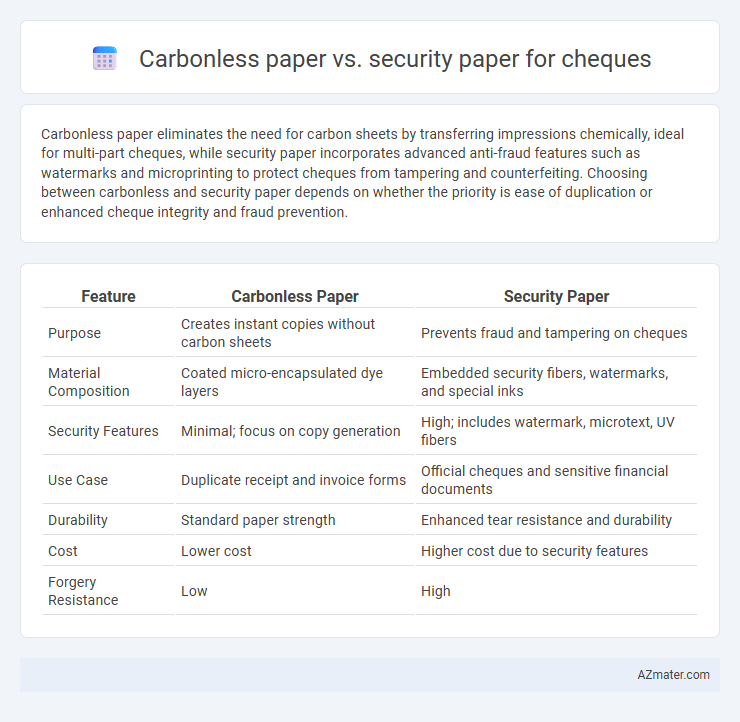Carbonless paper eliminates the need for carbon sheets by transferring impressions chemically, ideal for multi-part cheques, while security paper incorporates advanced anti-fraud features such as watermarks and microprinting to protect cheques from tampering and counterfeiting. Choosing between carbonless and security paper depends on whether the priority is ease of duplication or enhanced cheque integrity and fraud prevention.
Table of Comparison
| Feature | Carbonless Paper | Security Paper |
|---|---|---|
| Purpose | Creates instant copies without carbon sheets | Prevents fraud and tampering on cheques |
| Material Composition | Coated micro-encapsulated dye layers | Embedded security fibers, watermarks, and special inks |
| Security Features | Minimal; focus on copy generation | High; includes watermark, microtext, UV fibers |
| Use Case | Duplicate receipt and invoice forms | Official cheques and sensitive financial documents |
| Durability | Standard paper strength | Enhanced tear resistance and durability |
| Cost | Lower cost | Higher cost due to security features |
| Forgery Resistance | Low | High |
Introduction to Cheque Printing Papers
Cheque printing papers are essential in ensuring transaction security and clarity, with carbonless paper offering a clean, duplicate-free copy by transferring impressions without messy carbon sheets. Security paper enhances authentications using built-in features like watermarks, microprinting, and chemical sensitizers to prevent fraud and tampering. Both types play critical roles in banking documents but serve different purposes: carbonless paper maximizes operational efficiency, while security paper focuses on anti-counterfeiting measures.
What is Carbonless Paper?
Carbonless paper is a specially coated paper designed to transfer information written on the top sheet to underlying sheets without the need for carbon paper, commonly used in multi-part forms like invoices and receipts. Unlike security paper, which incorporates features such as watermarks, microprinting, and chemical sensitizers to prevent fraud and tampering in cheques, carbonless paper focuses solely on efficient duplicate creation. Its chemical micro-encapsulated coatings react under pressure from writing instruments, enabling clear copy reproduction without the risk of ink smudging or fading.
What is Security Paper?
Security paper is specially designed to prevent forgery and unauthorized copying of cheques through embedded features such as watermarks, microprinting, and chemical-sensitive fibers that reveal tampering attempts. Unlike carbonless paper, which facilitates duplicate creation without carbon sheets, security paper enhances cheque authenticity by providing multiple anti-counterfeiting layers. This ensures high-level protection against fraud in financial transactions, making it essential for secure cheque printing.
Key Features of Carbonless Paper
Carbonless paper used for cheques features micro-encapsulated dye or ink that transfers images without the need for carbon sheets, ensuring clean and efficient duplicate copies. It offers seamless and durable copy quality with high sensitivity to pressure, making it ideal for multi-part forms and cheques. Its lightweight and environmentally friendly composition enhances user convenience and reduces waste compared to traditional carbon paper.
Essential Security Features of Security Paper
Security paper for cheques incorporates essential security features such as watermarks, microprinting, and chemical-sensitive fibers that prevent tampering and fraudulent alterations, ensuring document authenticity. Carbonless paper lacks these advanced protections, relying instead on pressure-sensitive coatings to create duplicates without ink, which does not safeguard against counterfeiting or unauthorized modifications. The integration of UV-reactive elements and embedded security threads further distinguishes security paper, providing robust defense mechanisms critical to financial document integrity.
Carbonless Paper in Cheque Applications
Carbonless paper in cheque applications provides a clean, contactless method of creating duplicate copies without the mess of carbon sheets, enhancing efficiency in financial record-keeping. Its pressure-sensitive micro-encapsulated dye technology ensures instant and reliable copy formation, crucial for accurate transaction documentation. Compared to security paper, carbonless paper prioritizes convenience and fast reproduction while security paper focuses on fraud prevention through embedded anti-counterfeit features.
Security Paper in Cheque Applications
Security paper in cheque applications incorporates advanced features such as watermarks, microprinting, and embedded fibers to prevent fraud and unauthorized duplication. Unlike carbonless paper, which facilitates duplicate copies through chemical coatings, security paper emphasizes safeguarding the authenticity and integrity of the cheque. These security elements enhance the cheque's resistance to tampering, counterfeiting, and alteration, making security paper a crucial component in secure financial transactions.
Pros and Cons: Carbonless Paper vs Security Paper
Carbonless paper allows for instant duplicate copies without messy carbon sheets, making it efficient and eco-friendly, but it lacks advanced security features needed to prevent cheque fraud. Security paper incorporates watermarks, micro-printing, and chemical tampering detection, providing strong protection against counterfeiting and alteration, though it is typically more expensive and less environmentally friendly. Choosing between carbonless and security paper depends on the priority between convenience and enhanced fraud prevention for cheque transactions.
Cost Considerations in Cheque Printing
Carbonless paper for cheque printing generally incurs lower production costs due to its simpler manufacturing process and elimination of the need for separate carbon sheets. Security paper, designed with embedded features like watermarks, microprinting, and anti-tampering elements, demands higher expenses reflecting advanced materials and specialized treatments. Choosing between these options depends on balancing budget constraints against the necessity for fraud prevention and enhanced cheque integrity.
Choosing the Right Paper for Secure Cheques
Choosing the right paper for secure cheques involves understanding the distinct features of carbonless paper and security paper. Carbonless paper provides instant duplicates without messy carbon sheets, suitable for everyday transaction records, while security paper incorporates tamper-evident features such as watermarks, microprinting, and chemical sensitivity to prevent fraud and forgery. For enhanced cheque security, opt for security paper designed specifically to safeguard financial documents against alteration and counterfeiting.

Infographic: Carbonless paper vs Security paper for Cheque
 azmater.com
azmater.com